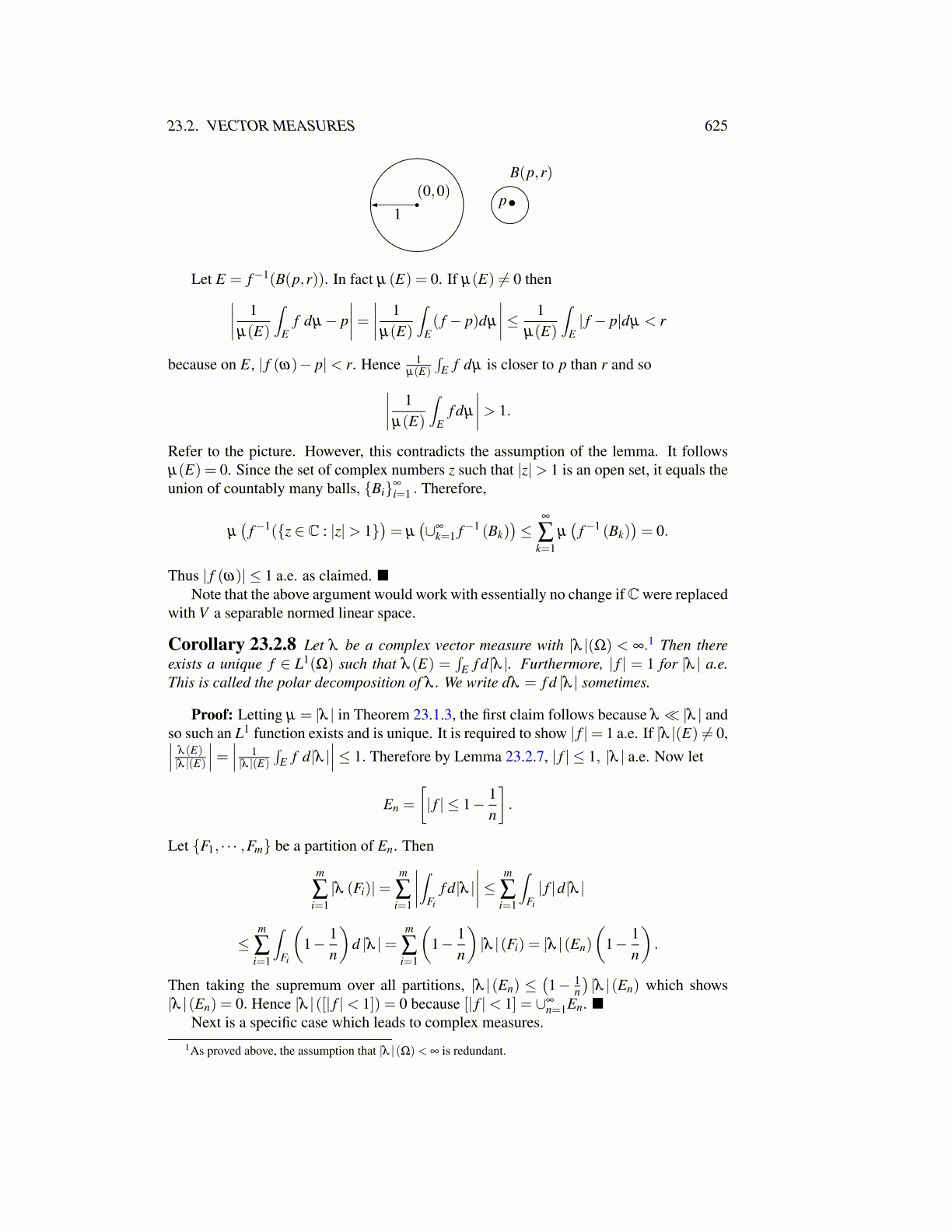
23.2. VECTOR MEASURES 625
1(0,0)
•p
B(p,r)
Let E = f−1(B(p,r)). In fact µ (E) = 0. If µ(E) ̸= 0 then∣∣∣∣ 1µ(E)
∫E
f dµ− p∣∣∣∣= ∣∣∣∣ 1
µ(E)
∫E( f − p)dµ
∣∣∣∣≤ 1µ(E)
∫E| f − p|dµ < r
because on E, | f (ω)− p|< r. Hence 1µ(E)
∫E f dµ is closer to p than r and so∣∣∣∣ 1
µ(E)
∫E
f dµ
∣∣∣∣> 1.
Refer to the picture. However, this contradicts the assumption of the lemma. It followsµ(E) = 0. Since the set of complex numbers z such that |z|> 1 is an open set, it equals theunion of countably many balls, {Bi}∞
i=1 . Therefore,
µ(
f−1({z ∈ C : |z|> 1})= µ
(∪∞
k=1 f−1 (Bk))≤
∞
∑k=1
µ(
f−1 (Bk))= 0.
Thus | f (ω)| ≤ 1 a.e. as claimed. ■Note that the above argument would work with essentially no change ifCwere replaced
with V a separable normed linear space.
Corollary 23.2.8 Let λ be a complex vector measure with |λ |(Ω) < ∞.1 Then thereexists a unique f ∈ L1(Ω) such that λ (E) =
∫E f d|λ |. Furthermore, | f | = 1 for |λ | a.e.
This is called the polar decomposition of λ . We write dλ = f d |λ | sometimes.
Proof: Letting µ = |λ | in Theorem 23.1.3, the first claim follows because λ ≪ |λ | andso such an L1 function exists and is unique. It is required to show | f |= 1 a.e. If |λ |(E) ̸= 0,∣∣∣ λ (E)|λ |(E)
∣∣∣= ∣∣∣ 1|λ |(E)
∫E f d|λ |
∣∣∣≤ 1. Therefore by Lemma 23.2.7, | f | ≤ 1, |λ | a.e. Now let
En =
[| f | ≤ 1− 1
n
].
Let {F1, · · · ,Fm} be a partition of En. Then
m
∑i=1|λ (Fi)|=
m
∑i=1
∣∣∣∣∫Fi
f d|λ |∣∣∣∣≤ m
∑i=1
∫Fi
| f |d|λ |
≤m
∑i=1
∫Fi
(1− 1
n
)d |λ |=
m
∑i=1
(1− 1
n
)|λ |(Fi) = |λ |(En)
(1− 1
n
).
Then taking the supremum over all partitions, |λ |(En) ≤(1− 1
n
)|λ |(En) which shows
|λ |(En) = 0. Hence |λ |([| f |< 1]) = 0 because [| f |< 1] = ∪∞n=1En. ■
Next is a specific case which leads to complex measures.1As proved above, the assumption that |λ |(Ω)< ∞ is redundant.